HONDA INSIGHT 2019 Owner's Manual (in English)
Manufacturer: HONDA, Model Year: 2019, Model line: INSIGHT, Model: HONDA INSIGHT 2019Pages: 675, PDF Size: 36.97 MB
Page 651 of 675
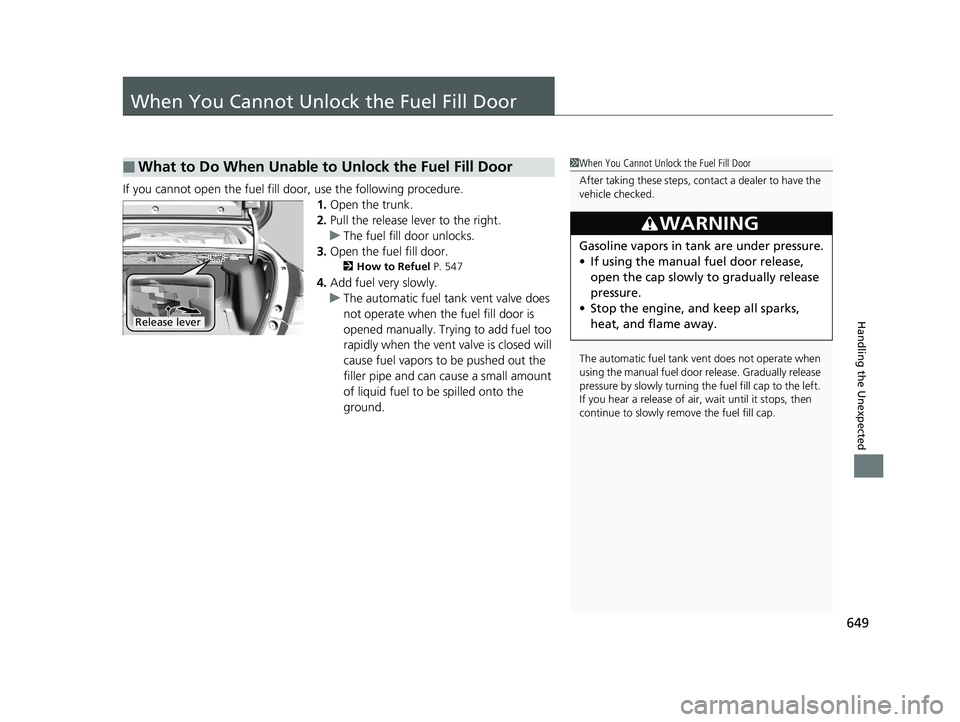
649
Handling the Unexpected
When You Cannot Unlock the Fuel Fill Door
If you cannot open the fuel fill door, use the following procedure.
1.Open the trunk.
2. Pull the release lever to the right.
u The fuel fill door unlocks.
3. Open the fuel fill door.
2 How to Refuel P. 547
4.Add fuel very slowly.
u The automatic fuel tank vent valve does
not operate when the fuel fill door is
opened manually. Trying to add fuel too
rapidly when the vent valve is closed will
cause fuel vapors to be pushed out the
filler pipe and can cause a small amount
of liquid fuel to be spilled onto the
ground.
■What to Do When Unable to Unlock the Fuel Fill Door1When You Cannot Unlock the Fuel Fill Door
After taking these steps, cont act a dealer to have the
vehicle checked.
The automatic fuel tank ve nt does not operate when
using the manual fuel door release. Gradually release
pressure by slowly turning th e fuel fill cap to the left.
If you hear a release of air, wait until it stops, then
continue to slowly remove the fuel fill cap.
3WARNING
Gasoline vapors in tank are under pressure.
• If using the manual fuel door release,
open the cap slowly to gradually release
pressure.
• Stop the engine, and keep all sparks,
heat, and flame away.
Release lever
19 INSIGHT HMIN-31TXM6000.book 649 ページ 2018年4月20日 金曜日 午後4時22分
Page 652 of 675
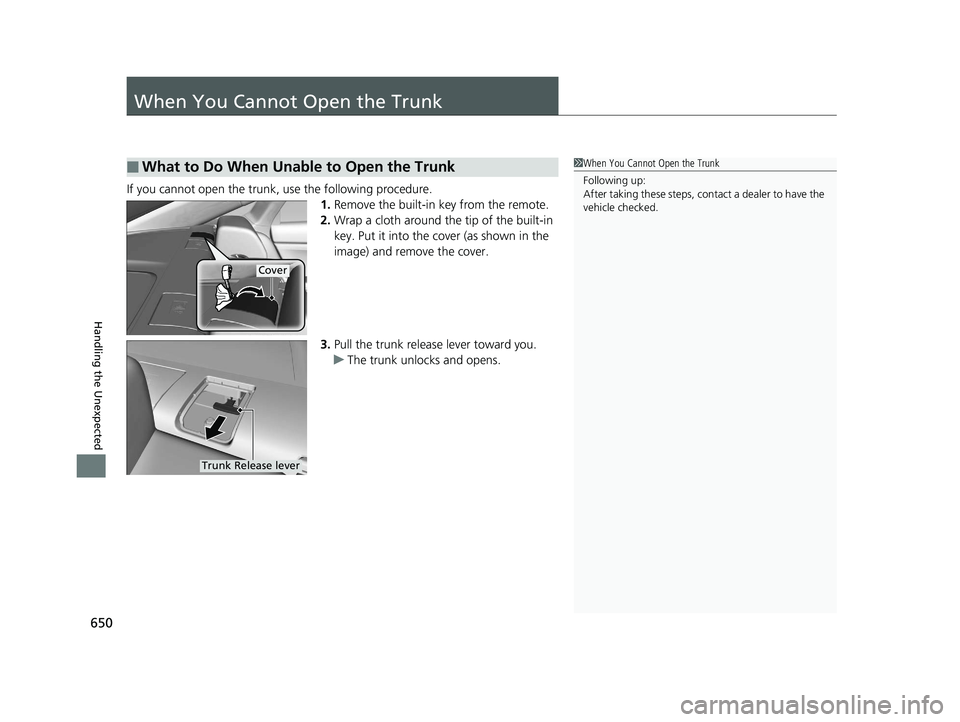
650
Handling the Unexpected
When You Cannot Open the Trunk
If you cannot open the trunk, use the following procedure.1.Remove the built-in key from the remote.
2. Wrap a cloth around the tip of the built-in
key. Put it into the cover (as shown in the
image) and remove the cover.
3. Pull the trunk release lever toward you.
u The trunk unlocks and opens.
■What to Do When Unable to Open the Trunk1When You Cannot Open the Trunk
Following up:
After taking these steps, cont act a dealer to have the
vehicle checked.
Cover
Trunk Release lever
19 INSIGHT HMIN-31TXM6000.book 650 ページ 2018年4月20日 金曜日 午後4時22分
Page 653 of 675
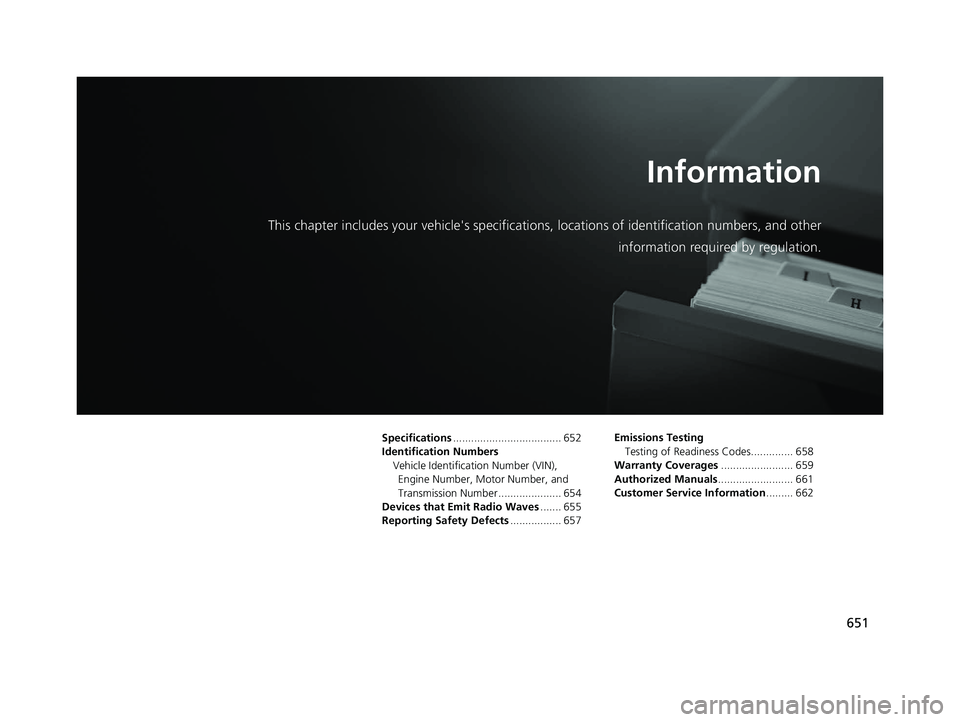
651
Information
This chapter includes your vehicle's specifications, locations of identification numbers, and other
information required by regulation.
Specifications .................................... 652
Identification Numbers Vehicle Identification Number (VIN), Engine Number, Motor Number, and
Transmission Number ..................... 654
Devices that Emit Radio Waves ....... 655
Reporting Safety Defects ................. 657Emissions Testing
Testing of Readiness Codes.............. 658
Warranty Coverages ........................ 659
Authorized Manuals ......................... 661
Customer Service Information ......... 662
19 INSIGHT HMIN-31TXM6000.book 651 ページ 2018年4月20日 金曜日 午後4時22分
Page 654 of 675
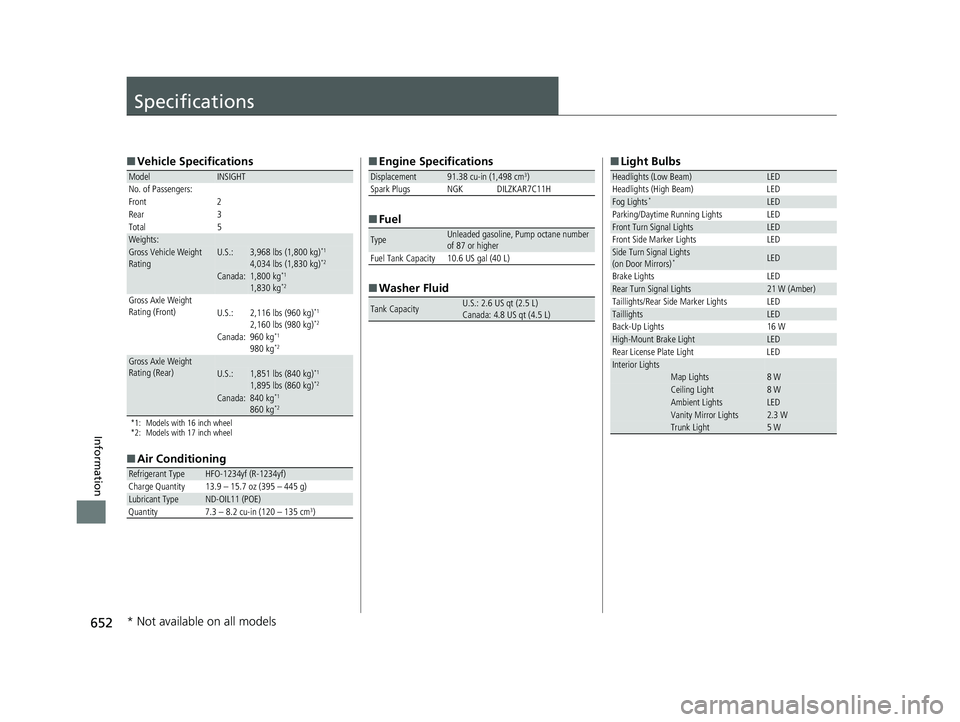
652
Information
Specifications
■Vehicle Specifications
*1: Models with 16 inch wheel
*2: Models with 17 inch wheel
■Air Conditioning
ModelINSIGHT
No. of Passengers:
Front 2
Rear 3
Total 5
Weights:Gross Vehicle Weight
Rating U.S.: 3,968 lbs (1,800 kg)*1
4,034 lbs (1,830 kg)*2
Canada: 1,800 kg*1
1,830 kg*2
Gross Axle Weight
Rating (Front)U.S.: 2,116 lbs (960 kg)*1
2,160 lbs (980 kg)*2
Canada: 960 kg*1
980 kg*2
Gross Axle Weight
Rating (Rear)U.S.: 1,851 lbs (840 kg)*1
1,895 lbs (860 kg)*2
Canada:840 kg*1
860 kg*2
Refrigerant TypeHFO-1234yf (R-1234yf)
Charge Quantity 13.9 – 15.7 oz (395 – 445 g)
Lubricant TypeND-OIL11 (POE)
Quantity 7.3 – 8.2 cu-in (120 – 135 cm3)
■ Engine Specifications
■ Fuel
■ Washer Fluid
Displacement91.38 cu-in (1,498 cm3)
Spark Plugs NGK DILZKAR7C11H
TypeUnleaded gasoline, Pump octane number
of 87 or higher
Fuel Tank Capacity 10.6 US gal (40 L)
Tank CapacityU.S.: 2.6 US qt (2.5 L)
Canada: 4.8 US qt (4.5 L)
■ Light Bulbs
Headlights (Low Beam)LED
Headlights (High Beam) LED
Fog Lights*LED
Parking/Daytime Running Lights LED
Front Turn Signal LightsLED
Front Side Marker Lights LED
Side Turn Signal Lights
(on Door Mirrors)*LED
Brake Lights LED
Rear Turn Signal Lights21 W (Amber)
Taillights/Rear Side Marker Lights LED
TaillightsLED
Back-Up Lights 16 W
High-Mount Brake LightLED
Rear License Plate Light LED
Interior LightsMap Lights8 WCeiling Light8 WAmbient LightsLEDVanity Mirror Lights2.3 WTrunk Light5 W
* Not available on all models
19 INSIGHT HMIN-31TXM6000.book 652 ページ 2018年4月20日 金曜日 午後4時22分
Page 655 of 675

653
uuSpecifications u
Information
■Brake Fluid
■ Transmission Fluid
SpecifiedHonda Heavy Duty Brake Fluid DOT 3
SpecifiedHonda Automatic Transmission Fluid
ATF DW-1
Capacity Change 2.3 US qt (2.2 L)
■ Engine Oil
■ Engine Coolant
■ Inverter Coolant
Recommended·Genuine Honda Motor Oil 0W-20
·API Premium-grade 0W-20 detergent oil
Capacity Change 3.3 US qt (3.1 L)
Change
including
filter
3.5 US qt (3.3 L)
SpecifiedHonda Long Life Antifreeze/Coolant Type2
Ratio 50/50 with distilled water
Capacity1.22 US gal (4.61 L)
(change including the remaining
0.14 US gal (0.52 L) in the reserve tank)
SpecifiedHonda Long Life Antifreeze/Coolant Type2
■ Tire
*1: Models with 16 inch wheel
*2: Models with 17 inch wheel
*3: Vehicles with optional spare tire
Regular
Size215/55R16 93V*1
215/50R17 91H*2
Pressure
psi (kPa [kgf/cm2])
Front35 (240 [2.4])
Rear33 (230 [2.3])*1
32 (220 [2.2])*2
Compact
Spare*3
Size T125/80D16 97M
Pressure
psi (kPa [kgf/cm
2]) 60 (420 [4.2])
Wheel SizeRegular16 x 7J*1
17 x 7J*2
Compact Spare*316 x 4T
19 INSIGHT HMIN-31TXM6000.book 653 ページ 2018年4月20日 金曜日 午後4時22分
Page 656 of 675
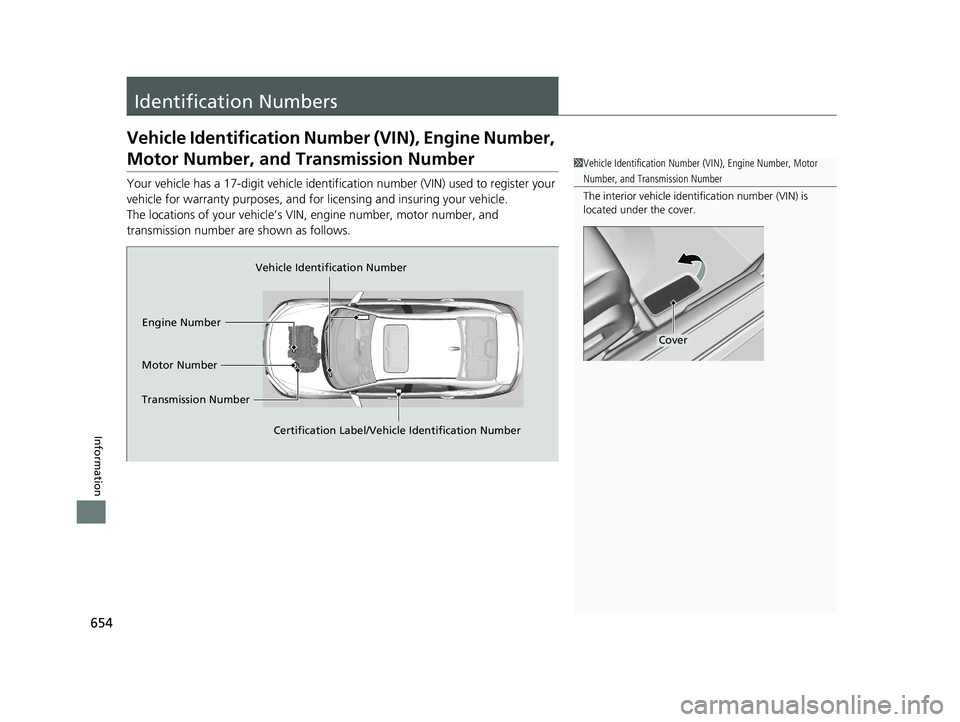
654
Information
Identification Numbers
Vehicle Identification Number (VIN), Engine Number,
Motor Number, and Transmission Number
Your vehicle has a 17-digit vehicle identifi cation number (VIN) used to register your
vehicle for warranty purposes, and for licensing and insuring your vehicle.
The locations of your vehicle’s VIN, engine number, motor number, and
transmission number are shown as follows.
1 Vehicle Identification Number (VIN), Engine Number, Motor
Number, and Transmission Number
The interior vehicle identification number (VIN) is
located under the cover.
Cover
Vehicle Identification Number
Engine Number
Certification Label/Vehicle Identification Number
Transmission Number Motor Number
19 INSIGHT HMIN-31TXM6000.book 654 ページ 2018年4月20日 金曜日 午後4時22分
Page 657 of 675
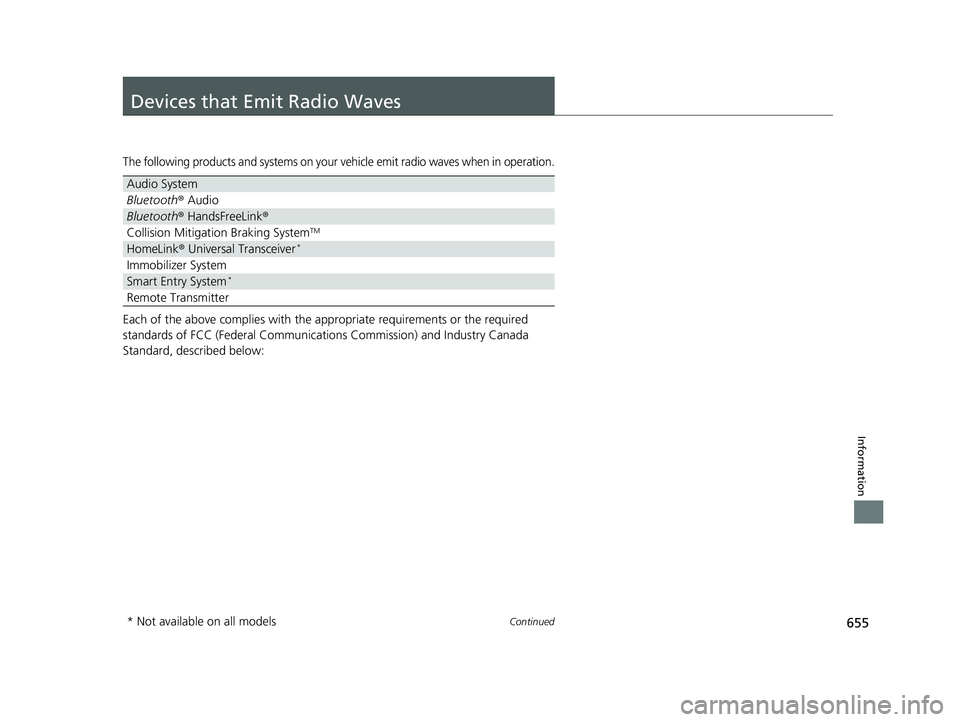
655Continued
Information
Devices that Emit Radio Waves
The following products and systems on your vehicle emit radio waves when in operation.
Each of the above complies with the appropriate requirements or the required
standards of FCC (Federal Communications Commission) and Industry Canada
Standard, described below:
Audio System
Bluetooth ® Audio
Bluetooth® HandsFreeLink ®
Collision Mitigation Braking SystemTM
HomeLink® Universal Transceiver*
Immobilizer System
Smart Entry System*
Remote Transmitter
* Not available on all models
19 INSIGHT HMIN-31TXM6000.book 655 ページ 2018年4月20日 金曜日 午後4時22分
Page 658 of 675
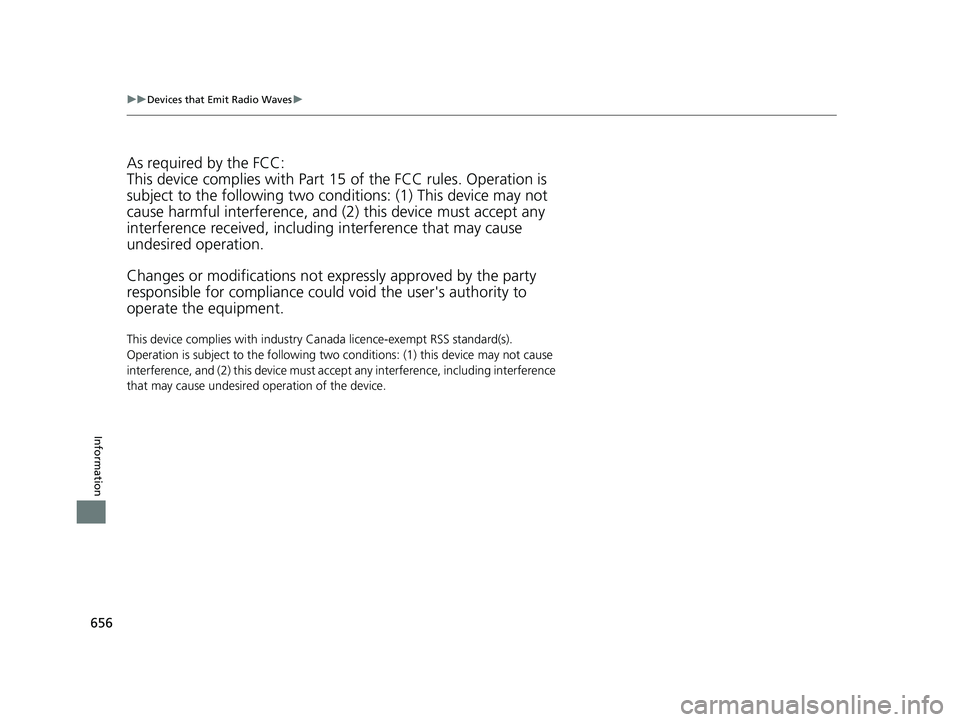
656
uuDevices that Emit Radio Waves u
Information
As required by the FCC:
This device complies with Part 15 of the FCC rules. Operation is
subject to the following two cond itions: (1) This device may not
cause harmful interference, and (2 ) this device must accept any
interference received, including interference that may cause
undesired operation.
Changes or modifications not expressly approved by the party
responsible for compli ance could void the user's authority to
operate the equipment.
This device complies with industry Ca nada licence-exempt RSS standard(s).
Operation is subject to the following two conditions: (1) this device may not cause
interference, and (2) this device must acce pt any interference, including interference
that may cause undesired operation of the device.
19 INSIGHT HMIN-31TXM6000.book 656 ページ 2018年4月20日 金曜日 午後4時22分
Page 659 of 675
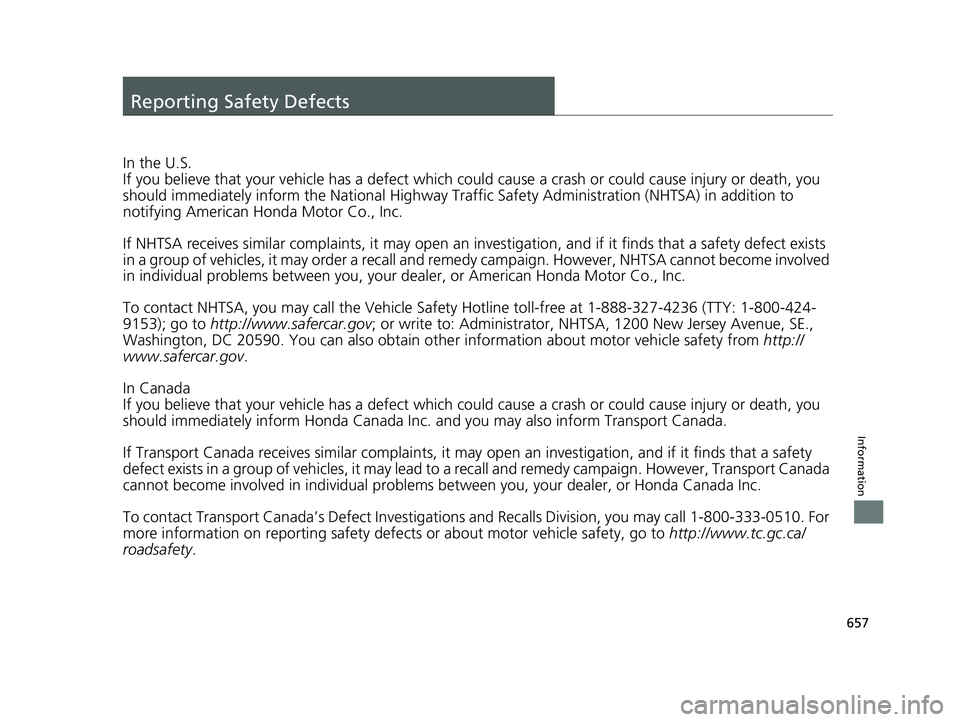
657
Information
Reporting Safety Defects
In the U.S.
If you believe that your vehicle has a defect which could cause a crash or could cause injury or death, you
should immediately inform the National Highway Traffic Safety Admi nistration (NHTSA) in addition to
notifying American Honda Motor Co., Inc.
If NHTSA receives similar complaints, it may open an investigation, and if it finds that a safety defect exists
in a group of vehicles, it may order a recall and reme dy campaign. However, NHTSA cannot become involved
in individual problems between you, your dealer, or American Honda Motor Co., Inc.
To contact NHTSA, you may call the Vehicle Safety Hotline toll-free at 1-888-327-4236 (TTY: 1-800-424-
9153); go to http://www.safercar.gov ; or write to: Administrator, NHTSA, 1200 New Jersey Avenue, SE.,
Washington, DC 20590. You can also obtain othe r information about motor vehicle safety from http://
www.safercar.gov .
In Canada
If you believe that your vehicle has a defect which could cause a crash or could cause injury or death, you
should immediately inform Honda Canada Inc. and you may also inform Transport Canada.
If Transport Canada receives similar complaints, it may open an investigation, and if it finds that a safety
defect exists in a group of vehicles, it may lead to a recall and remedy campaign. However, Transport Canada
cannot become involved in individual problems between you, your dealer, or Honda Canada Inc.
To contact Transport Canada’s Defect Investigations and Recalls Division, you may call 1-800-333-0510. For
more information on reporting safety defe cts or about motor vehicle safety, go to http://www.tc.gc.ca/
roadsafety .
19 INSIGHT HMIN-31TXM6000.book 657 ページ 2018年4月20日 金曜日 午後4時22分
Page 660 of 675
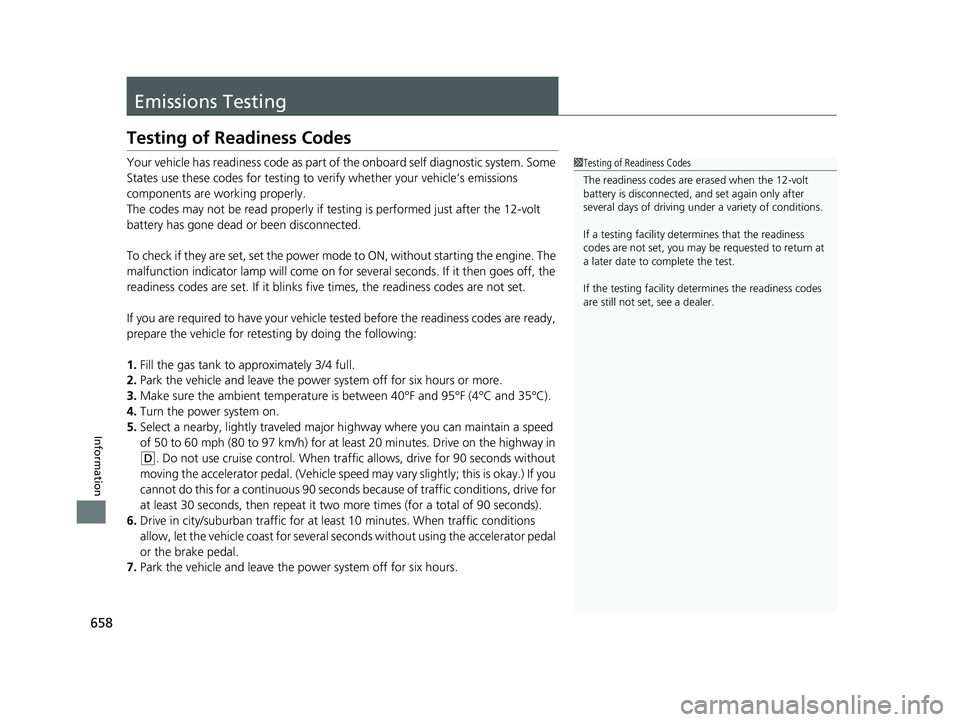
658
Information
Emissions Testing
Testing of Readiness Codes
Your vehicle has readiness code as part of the onboard self diagnostic system. Some
States use these codes for testing to verify whether your vehicle’s emissions
components are working properly.
The codes may not be read properly if te sting is performed just after the 12-volt
battery has gone dead or been disconnected.
To check if they are set, set the power mo de to ON, without starting the engine. The
malfunction indicator lamp will come on for several seconds. If it then goes off, the
readiness codes are set. If it blinks fi ve times, the readiness codes are not set.
If you are required to have your vehicle te sted before the readiness codes are ready,
prepare the vehicle for retesting by doing the following:
1. Fill the gas tank to approximately 3/4 full.
2. Park the vehicle and leave the power system off for six hours or more.
3. Make sure the ambient temperature is between 40°F and 95°F (4°C and 35°C).
4. Turn the power system on.
5. Select a nearby, lightly traveled major hi ghway where you can maintain a speed
of 50 to 60 mph (80 to 97 km/h) for at least 20 minutes. Drive on the highway in
(D. Do not use cruise control. When tra ffic allows, drive for 90 seconds without
moving the accelerator pedal. (Vehicle spee d may vary slightly; this is okay.) If you
cannot do this for a continuous 90 seconds because of traffic conditions, drive for
at least 30 seconds, then repeat it two mo re times (for a total of 90 seconds).
6. Drive in city/suburban traffic for at least 10 minutes. When traffic conditions
allow, let the vehicle coast for several se conds without using the accelerator pedal
or the brake pedal.
7. Park the vehicle and leave the power system off for six hours.
1Testing of Readiness Codes
The readiness codes are erased when the 12-volt
battery is disconnected, and set again only after
several days of driving unde r a variety of conditions.
If a testing facility determines that the readiness
codes are not set, you may be requested to return at
a later date to complete the test.
If the testing facility determines the readiness codes
are still not set, see a dealer.
19 INSIGHT HMIN-31TXM6000.book 658 ページ 2018年4月20日 金曜日 午後4時22分